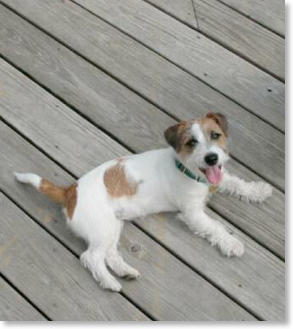Tail Docking

We realize the subject of tail docking (and the removal of dew claws) is a sensitive one and the choice to dock or not is entirely up to the breeder. Since October 2006, we have not practiced tail docking (or dew claw removal) on our Jack Russell Terriers. We do not condemn other Jack Russell Terrier breeders for this practice - Some who work their dogs in a serious manner say it is to prevent injury to their working pack. For us, it is a personal choice - studies and statistics have shown it is not necessary for an overwhelming majority of dogs. We accept our terriers in their natural state, will not mutilate them or put the pups through this procedure just for the sake of “following the crowd”. We will not dock your puppies tail. And will ask that you leave the tail natural. AVMA position statement
Tail Docking Facts:
The tail is part of the spinal column comprising approximately 20 coccygeal vertebrae, muscle, nerves and a blood supply. The muscular structure plays an important role in body shape, function and communication.
The tail is used as a counterbalance in various locomotory activities: running, walking and squatting to defecate.
Docking is a surgical amputation, which involves cutting or crushing a puppy's skin, muscles, up to seven pairs of nerves, and bone and cartilage - and is performed without anesthetic when pups are days old. At this age they can feel pain, and research indicates they do so at a greater intensity than adult dogs because the ability to suppress pain develops with age and experience.
When pain is felt, is it the result of nerve impulses going to the brain. The pain-transmitting nerve impulses can be reduced in intensity by a second group of 'inhibitory nerves'. These 'inhibitory nerves' reduce the severity of the 'pain message'. This process works well in adult humans and animals to reduce pain sensation. However in puppies, the pain inhibitory pathways are not well developed. So, instead of not feeling as much pain as an adult animal, a pup is likely to feel more pain. The pup is an innocent victim as it cannot express fully the pain it is feeling.
There is now scientific evidence showing that puppies feel pain during the process of docking.
LIFE LONG IMPLICATIONS: The tail is used to communicate the mood and attitude of the dog: its emotional state, assertion of social status, acceptance of a subordinate or equal position, or willingness to fight. Further, the use of the tail to communicate is essential to a dog’s well being. Studies have proven that dogs with docked tails and cropped ears are more likely to be misread by other dogs and end up in confrontation.

DOG FANCIER TAKES TAIL DOCKING PROTEST TO SHOW RING
Legal status of dog tail docking and ear cropping by country



